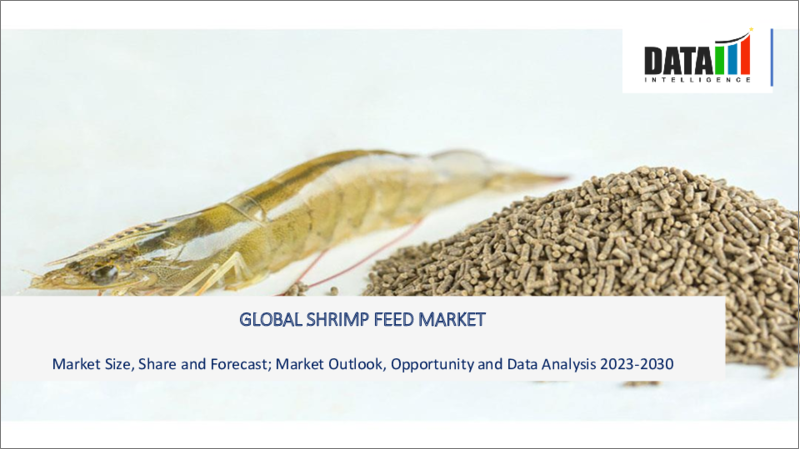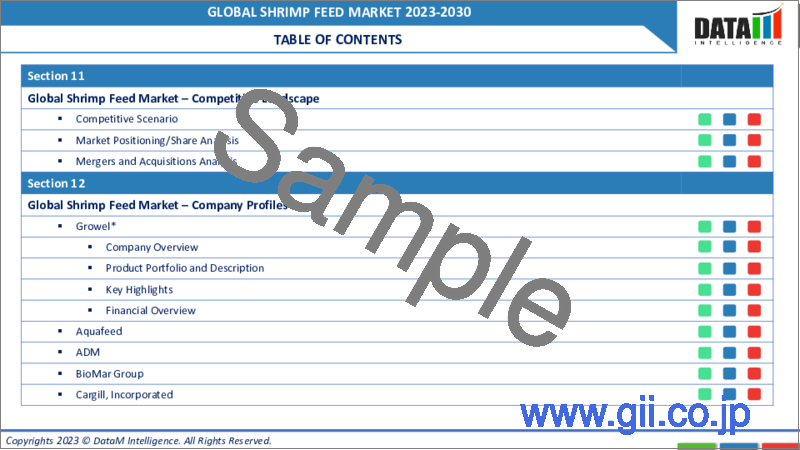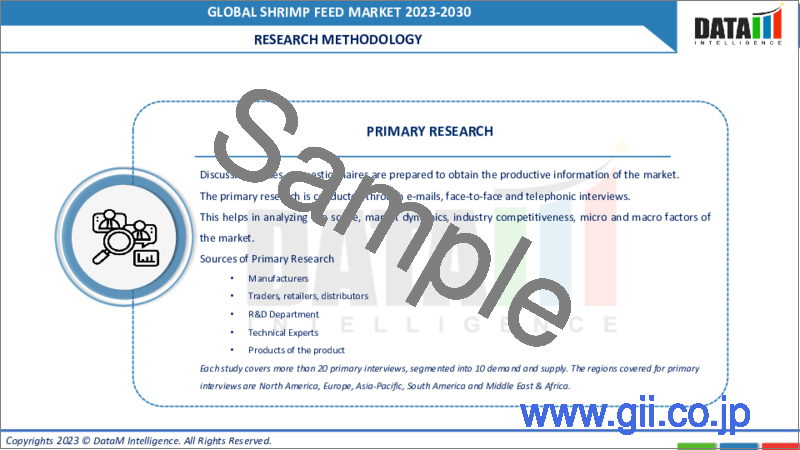|
|
市場調査レポート
商品コード
1319252
エビ飼料の世界市場-2023年~2030年Global Shrimp Feed Market - 2023-2030 |
||||||
カスタマイズ可能
適宜更新あり
|
|||||||
| エビ飼料の世界市場-2023年~2030年 |
|
出版日: 2023年07月31日
発行: DataM Intelligence
ページ情報: 英文 190 Pages
納期: 即日から翌営業日
|
- 全表示
- 概要
- 目次
市場概要
世界のエビ飼料市場は、2022年に65億米ドルに達し、2023年から2030年の予測期間中にCAGR 5.2%で成長し、2030年には97億米ドルに達すると予測されています。
シュリンプフィードとは、養殖エビの成長、健康、成績に必要な栄養を満たすために、養殖事業で養殖エビに提供される専用の飼料を指します。水産飼料の一種であり、水産動物用に特別に設計された飼料を指します。
エビの栄養は、エビ飼料の配合において重要な考慮事項です。エビは、タンパク質、ビタミン、ミネラル、その他の必須栄養素について、特定の食事要件を備えています。飼料の配合には、必要な栄養素を適切な割合で供給するために、原材料を慎重に選択し、バランスをとることが必要です。
エビ飼料業界では、飼料配合の技術や手法が進歩しています。エビの栄養所要量に関する理解が深まり、研究開発が進んだ結果、エビの成長、健康、全体的なパフォーマンスを最適化する特殊な飼料が開発されるようになっています。
市場力学
エビの健康と疾病管理の重視がエビ飼料市場を牽引
エビの養殖は様々な病気の影響を受けやすく、生産量や収益性に大きな影響を与える可能性があります。早期死亡症候群(EMS)、白点症候群ウイルス(WSSV)などの病気は、高い死亡率と経済的損失を引き起こす可能性があります。例えば、スレーシュ博士は世界・アクアフィード・アライアンスが発表した前述の記事の中で、インドのエビ養殖産業は、推定550から600の孵化場から年間1200億のポストラーベ(PL)の生産能力を確立していると述べています。
エビの飼料は、エビの健康と疾病管理をサポートする上で重要な役割を果たしています。高品質のエビ用飼料は、必須栄養素、免疫強化剤、プロバイオティクスが配合されており、エビの免疫システムを強化し、病気に対する抵抗力や回復力を高めることができます。エビ用飼料が提供するバランスのとれた栄養は、エビの全体的な健康と活力を維持し、病気にかかりにくくします。
飼料配合の技術的進歩がエビ飼料市場を促進すると期待される
飼料配合の技術的進歩により、エビのライフサイクルのさまざまな段階における特定の栄養要件がよりよく理解されるようになっています。調査や科学的研究は、エビの成長、健康、総合的なパフォーマンスを促進する必須栄養素、アミノ酸、ビタミン、ミネラルの特定に役立っています。
例えば、ノルウェーに本社を置く水産飼料と栄養の世界的リーダーであるSkretting社は、2万平方メートルの敷地に約165億ルピーを投じて建設された、エビと魚の両方の養殖に対応する最新鋭のエビ・魚用飼料生産施設を落成させました。
技術の進歩により、エビの飼料効率と成長率を最大化するための飼料配合の最適化が可能になっています。エビの栄養利用、消化、吸収を高めるために、飼料添加物、酵素、プロバイオティクスの使用が増加しています。その結果、飼料要求率(FCR)が改善され、飼料の浪費が減り、エビの成長が促進され、養殖業者の収益向上につながります。
エビの疾病発生と健康課題がエビ飼料市場の妨げになっている
疾病の発生は、エビ養殖産業に大きな経済的影響を及ぼす可能性があります。早期死亡症候群(EMS)、白点症候群ウイルス(WSSV)などの病気は、高い死亡率を引き起こし、エビ養殖業者の経済的損失につながります。このような損失はエビ養殖事業の収益性に影響を与えるため、養殖業者はエビ飼料などの飼料製品に投資することが難しくなります。
エビ養殖業者は、病気の予防と治療のために追加費用がかかることが多いです。これには、病気のモニタリング、診断、バイオセキュリティ対策、病気をコントロールするための治療薬や化学薬品の使用に関する費用が含まれます。こうしたコストの増加はエビ養殖業者の財源を圧迫し、エビ飼料製品への投資能力を制限する可能性があります。
COVID-19影響分析
COVID-19分析には、COVID前シナリオ、COVIDシナリオ、COVID後シナリオに加え、価格力学(COVID前シナリオと比較したパンデミック中およびパンデミック後の価格変動を含む)、需給スペクトラム(取引制限、封鎖、およびその後の問題による需給の変化)、政府の取り組み(政府機関による市場、セクター、産業を活性化するための取り組み)、メーカーの戦略的取り組み(COVID問題を緩和するためにメーカーが行ったことをここで取り上げる)が含まれます。
目次
第1章 調査手法と調査範囲
第2章 市場の定義と概要
第3章 エグゼクティブサマリー
第4章 市場力学
- 市場への影響要因
- 促進要因
- 抑制要因
- 機会
- 影響分析
第5章 産業分析
- ポーターのファイブフォース分析
- サプライチェーン分析
- 価格分析
- 規制分析
第6章 COVID-19分析
第7章 タイプ別
- グロアー
- フィニッシャー
- スターター
第8章 成分別
- 大豆ミール
- 魚粉
- 小麦粉
- 魚油
- その他
第9章 添加物別
- ビタミンとタンパク質
- 脂肪酸
- 酸化防止剤
- 飼料酵素
- 抗生物質
- その他
第10章 地域別
- 北米
- 米国
- カナダ
- メキシコ
- 欧州
- ドイツ
- 英国
- フランス
- イタリア
- スペイン
- その他欧州
- 南米
- ブラジル
- アルゼンチン
- その他南米
- アジア太平洋
- 中国
- インド
- 日本
- オーストラリア
- その他アジア太平洋地域
- 中東・アフリカ
第11章 競合情勢
- 競合シナリオ
- 市況/シェア分析
- M&A分析
第12章 企業プロファイル
- Growel Feeds Pvt.
- 会社概要
- 製品ポートフォリオと説明
- 財務概要
- 主な発展
- DuPont
- ADM
- BioMar Group A/S
- Cargill, Incorporated
- Nutreco
- Novozymes AS
- Charoen Pokphand Foods PCL
- Evonik Industries AG
- Avanti Feeds Ltd.
第13章 付録
Market Overview
Global Shrimp Feed Market reached US$ 6.5 billion in 2022 and is expected to reach US$ 9.7 billion by 2030 growing with a CAGR of 5.2% during the forecast period 2023-2030.
Shrimp feed refers to the specialized feed formulated and provided to farmed shrimp in aquaculture operations to meet their nutritional requirements for growth, health, and performance. It is a type of aquafeed, which refers to feeds specifically designed for aquatic animals.
Shrimp nutrition is a key consideration in shrimp feed formulation. Shrimp have specific dietary requirements for proteins, vitamins, minerals, and other essential nutrients. Feed formulation involves the careful selection and balancing of ingredients to provide the necessary nutrients in the appropriate proportions.
The shrimp feed industry has witnessed advancements in feed formulation techniques and technologies. Improved understanding of shrimp nutritional requirements, along with research and development efforts, has resulted in the development of specialized feeds that optimize shrimp growth, health, and overall performance.
Market Dynamics
Focus on Shrimp Health and Disease Management is Driving the Shrimp Feed Market
Shrimp farming is susceptible to various diseases that can significantly impact production and profitability. Diseases like Early Mortality Syndrome (EMS), White Spot Syndrome Virus (WSSV), and others can cause high mortality rates and economic losses. For instance, Dr. Suresh stated in the aforementioned article, published by the Global Aquafeed Alliance, that the Indian shrimp farming industry has an established production capacity of 120 billion postlarvae (PLs) per year, from an estimated 550 to 600 hatcheries.
Shrimp feed plays a vital role in supporting shrimp health and disease management. High-quality shrimp feeds are formulated to contain essential nutrients, immune enhancers, and probiotics that can strengthen the immune system of shrimp, helping them resist and recover from diseases. Well-balanced nutrition provided by shrimp feed helps maintain the overall health and vitality of shrimp, making them more resilient to diseases.
Technological Advancements in Feed Formulation is Expected to Foster the Shrimp Feed Market
Technological advancements in feed formulation have led to a better understanding of the specific nutritional requirements of shrimp at different stages of their lifecycle. Research and scientific studies have helped identify the essential nutrients, amino acids, vitamins, and minerals that promote shrimp growth, health, and overall performance.
For instance, Norway-based Skretting, a global leader in aquafeed and nutrition, inaugurated its state-of-the-art production facility for shrimp and fish feed which is spread over an area of 20,000 sq mt and built with an investment of around Rs. 165 crore, the facility will cater to both shrimp and fish cultures.
Technological advancements have allowed for the optimization of feed formulations to maximize feed efficiency and growth rates in shrimp. Feed additives, enzymes, and probiotics are increasingly used to enhance nutrient utilization, digestion, and absorption in shrimp. This results in improved feed conversion ratios (FCR), reduced feed wastage, and enhanced shrimp growth, leading to increased profitability for farmers.
Disease Outbreaks and Health Challenges of Shrimps is Hindering the Shrimp Feed Market
Disease outbreaks can have significant economic consequences for the shrimp farming industry. Diseases such as Early Mortality Syndrome (EMS), White Spot Syndrome Virus (WSSV), and others can cause high mortality rates and lead to financial losses for shrimp farmers. These losses can impact the profitability of shrimp farming operations, making it challenging for farmers to invest in feed products, including shrimp feed.
Shrimp farmers often incur additional costs for disease prevention and treatment. This can include expenses related to disease monitoring, diagnostics, biosecurity measures, and the use of treatments or chemicals to control diseases. These increased costs can strain the financial resources of shrimp farmers, potentially limiting their ability to invest in shrimp feed products.
COVID-19 Impact Analysis
The COVID-19 Analysis includes Pre-COVID Scenario, COVID Scenario, and Post-COVID Scenario along with Pricing Dynamics (Including pricing change during and post-pandemic comparing it with pre-COVID scenarios), Demand-Supply Spectrum (Shift in demand and supply owing to trading restrictions, lockdown, and subsequent issues), Government Initiatives (Initiatives to revive market, sector or Industry by Government Bodies) and Manufacturers Strategic Initiatives (What manufacturers did to mitigate the COVID issues will be covered here).
Segment Analysis
The global shrimp feed market is segmented based on type, ingredients, additives, and region.
By Ingredient, the Soybean Meal Segment is Estimated to have Significant Growth During the Forecast Period
Soybeans are one of the most widely cultivated and produced oilseed crops globally. According to the Food and Agriculture Organization (FAO), the global production of soybeans reached a record high of 372 million metric tons in 2020. This high production volume contributes to the availability and affordability of soybean meal in the market, which drives its market share.
Soybean meal is renowned for its high protein content and balanced amino acid profile, making it an important ingredient in animal feed. Livestock, poultry, and aquaculture industries rely heavily on soybean meal as a source of protein for their animal feed formulations. The nutritional benefits and cost-effectiveness of soybean meal contribute to its widespread usage, resulting in a larger market share.
Geographical Analysis
North America is the Fastest Growing Market in the Shrimp Feed Market
Shrimp intake has been steadily increasing in North America over the years. The growing consciousness of the health benefits associated with seafood consumption and the recognition of shrimp as a flexible and delicious protein supply have contributed to its growing demand within the vicinity. The expanded consumption of shrimp creates a favorable market surroundings for the shrimp feed industry.
Shrimp aquaculture, also known as shrimp farming, has been gaining traction in North America. This is due to factors such as declining wild shrimp shares and the desire for more sustainable seafood production methods. Shrimp farming requires the use of specialized feed to provide the important nutrients for most fulfilling growth and health of the shrimp. As shrimp aquaculture continues to expand in North America, the demand for shrimp feed is anticipated to increase.
Competitive Landscape
The major global players in the market include: Growel Feeds Pvt., DuPont, ADM, BioMar Group A/S, Cargill, Incorporated, Nutreco, Novozymes AS, Charoen Pokphand Foods PCL, Evonik Industries AG, and Avanti Feeds Ltd.
Why Purchase the Report?
- To visualize the global shrimp feed market segmentation based on type, ingredients, additives, and region, as well as understand key commercial assets and players.
- Identify commercial opportunities in the market by analyzing trends and co-development.
- Excel data sheet with numerous data points of shrimp feed market-level with all segments.
- The PDF report consists of cogently put-together market analysis after exhaustive qualitative interviews and in-depth market study.
- Product mapping is available as Excel consists of key products of all the major market players.
The global shrimp feed market report would provide approximately 61 tables, 60 figures, and 190 Pages.
Target Audience 2023
- Manufacturers/ Buyers
- Industry Investors/Investment Bankers
- Research Professionals
- Emerging Companies
Table of Contents
1. Methodology and Scope
- 1.1. Research Methodology
- 1.2. Research Objective and Scope of the Report
2. Market Definition and Overview
3. Executive Summary
- 3.1. Market Snippet, by Type
- 3.2. Market Snippet, by Ingredient
- 3.3. Market Snippet, by Additives
- 3.4. Market Snippet, by Region
4. Market Dynamics
- 4.1. Market Impacting Factors
- 4.1.1. Drivers
- 4.1.2. Restraints
- 4.1.3. Opportunity
- 4.1.4. Impact Analysis
5. Industry Analysis
- 5.1. Porter's Five Force Analysis
- 5.2. Supply Chain Analysis
- 5.3. Pricing Analysis
- 5.4. Regulatory Analysis
6. COVID-19 Analysis
- 6.1. Analysis of COVID-19 on the Market
- 6.1.1. Scenario Before COVID-19
- 6.1.2. Scenario During COVID-19
- 6.1.3. Scenario Post COVID-19
- 6.2. Pricing Dynamics Amid COVID-19
- 6.3. Demand-Supply Spectrum
- 6.4. Government Initiatives Related to the Market During Pandemic
- 6.5. Manufacturers Strategic Initiatives
- 6.6. Conclusion
7. By Type
- 7.1. Introduction
- 7.1.1. Market Size Analysis and Y-o-Y Growth Analysis (%), By Type
- 7.1.2. Market Attractiveness Index, By Type
- 7.2. Grower*
- 7.2.1. Introduction
- 7.2.2. Market Size Analysis and Y-o-Y Growth Analysis (%)
- 7.3. Finisher
- 7.4. Starter
8. By Ingredient
- 8.1. Introduction
- 8.1.1. Market Size Analysis and Y-o-Y Growth Analysis (%), By Ingredient
- 8.1.2. Market Attractiveness Index, By Ingredient
- 8.2. Soybean Meal*
- 8.2.1. Introduction
- 8.2.2. Market Size Analysis and Y-o-Y Growth Analysis (%)
- 8.3. Fish Meal
- 8.4. Wheat Flour
- 8.5. Fish Oil
- 8.6. Others
9. By Additive
- 9.1. Introduction
- 9.1.1. Market Size Analysis and Y-o-Y Growth Analysis (%), By Additive
- 9.1.2. Market Attractiveness Index, By Additive
- 9.2. Vitamins and Proteins*
- 9.2.1. Introduction
- 9.2.2. Market Size Analysis and Y-o-Y Growth Analysis (%)
- 9.3. Fatty Acids
- 9.4. Antioxidants
- 9.5. Feed Enzymes
- 9.6. Antibiotics
- 9.7. Others
10. By Region
- 10.1. Introduction
- 10.1.1. Market Size Analysis and Y-o-Y Growth Analysis (%), By Region
- 10.1.2. Market Attractiveness Index, By Region
- 10.2. North America*
- 10.2.1. Introduction
- 10.2.2. Key Region-Specific Dynamics
- 10.2.3. Market Size Analysis and Y-o-Y Growth Analysis (%), By Type
- 10.2.4. Market Size Analysis and Y-o-Y Growth Analysis (%), By Ingredient
- 10.2.5. Market Size Analysis and Y-o-Y Growth Analysis (%), By Additive
- 10.2.6. Market Size Analysis and Y-o-Y Growth Analysis (%), By Country
- 10.2.6.1. The U.S.
- 10.2.6.2. Canada
- 10.2.6.3. Mexico
- 10.3. Europe
- 10.3.1. Introduction
- 10.3.2. Key Region-Specific Dynamics
- 10.3.3. Market Size Analysis and Y-o-Y Growth Analysis (%), By Type
- 10.3.4. Market Size Analysis and Y-o-Y Growth Analysis (%), By Ingredient
- 10.3.5. Market Size Analysis and Y-o-Y Growth Analysis (%), By Additive
- 10.3.6. Market Size Analysis and Y-o-Y Growth Analysis (%), By Country
- 10.3.6.1. Germany
- 10.3.6.2. The U.K.
- 10.3.6.3. France
- 10.3.6.4. Italy
- 10.3.6.5. Spain
- 10.3.6.6. Rest of Europe
- 10.4. South America
- 10.4.1. Introduction
- 10.4.2. Key Region-Specific Dynamics
- 10.4.3. Market Size Analysis and Y-o-Y Growth Analysis (%), By Type
- 10.4.4. Market Size Analysis and Y-o-Y Growth Analysis (%), By Ingredient
- 10.4.5. Market Size Analysis and Y-o-Y Growth Analysis (%), By Additive
- 10.4.6. Market Size Analysis and Y-o-Y Growth Analysis (%), By Country
- 10.4.6.1. Brazil
- 10.4.6.2. Argentina
- 10.4.6.3. Rest of South America
- 10.5. Asia-Pacific
- 10.5.1. Introduction
- 10.5.2. Key Region-Specific Dynamics
- 10.5.3. Market Size Analysis and Y-o-Y Growth Analysis (%), By Type
- 10.5.4. Market Size Analysis and Y-o-Y Growth Analysis (%), By Ingredient
- 10.5.5. Market Size Analysis and Y-o-Y Growth Analysis (%), By Additive
- 10.5.6. Market Size Analysis and Y-o-Y Growth Analysis (%), By Country
- 10.5.6.1. China
- 10.5.6.2. India
- 10.5.6.3. Japan
- 10.5.6.4. Australia
- 10.5.6.5. Rest of Asia-Pacific
- 10.6. Middle East and Africa
- 10.6.1. Introduction
- 10.6.2. Key Region-Specific Dynamics
- 10.6.3. Market Size Analysis and Y-o-Y Growth Analysis (%), By Type
- 10.6.4. Market Size Analysis and Y-o-Y Growth Analysis (%), By Ingredient
- 10.6.5. Market Size Analysis and Y-o-Y Growth Analysis (%), By Additive
11. Competitive Landscape
- 11.1. Competitive Scenario
- 11.2. Market Positioning/Share Analysis
- 11.3. Mergers and Acquisitions Analysis
12. Company Profiles
- 12.1. Growel Feeds Pvt.*
- 12.1.1. Company Overview
- 12.1.2. Product Portfolio and Description
- 12.1.3. Financial Overview
- 12.1.4. Key Developments
- 12.2. DuPont
- 12.3. ADM
- 12.4. BioMar Group A/S
- 12.5. Cargill, Incorporated
- 12.6. Nutreco
- 12.7. Novozymes AS
- 12.8. Charoen Pokphand Foods PCL
- 12.9. Evonik Industries AG
- 12.10. Avanti Feeds Ltd.
LIST NOT EXHAUSTIVE
13. Appendix
- 13.1. About Us and Services
- 13.2. Contact Us






